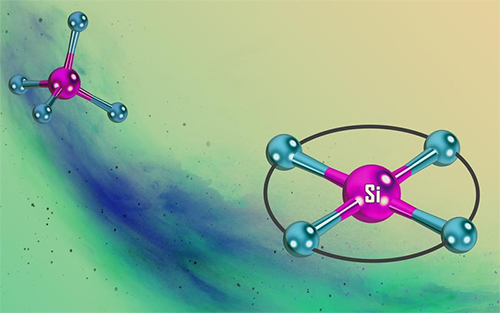| Jul 22, 2021 |
Silicon with a two-dimensional structure
(Nanowerk News) Silicon, a semi-metal, bonds in its natural form with four other elements and its three-dimensional structure takes the form of a tetrahedron. For a long time, it seemed impossible to achieve the synthesis and characterisation of a two-dimensional equivalent – geometrically speaking, a square.
|
|
Now scientists from the field of Inorganic Chemistry at Heidelberg University have succeeded in producing a crystalline complex with such a configuration. PD Dr Lutz Greb from the Institute of Inorganic Chemistry underlines that it has surprising physical and chemical properties and, in the field of molecular chemistry, will open up new approaches to using the second most abundant element in the Earth’s crust for catalysis and materials research (Chem, "An isolable, crystalline complex of square-planar silicon(IV)").
|
 |
| Changes to the natural tetrahedral structure of silicon (top left) in an unusual square planar geometry (bottom right). (Image: Ebner/Greb)
|
|
As a classical semi-metal, silicon possesses properties of both metals and non-metals, and belongs to the carbon group on the periodic table. Like carbon, silicon bonds with four elements. Its three-dimensional structure then corresponds to a tetrahedron, a body with four sides. Due to the high stability of a tetrahedron, other structures are not known in natural silicon with four bonds – silicon(IV) for short.
|
|
Considered purely geometrically, the two-dimensional equivalent to a tetrahedron is a square. These configurations are already known for carbon but, according to Dr Greb, a square-planar structure has not yet been produced in the field of silicon(IV) chemistry, even after over 40 years of intensive effort.
|
|
Dr Greb’s working group has succeeded for the first time in synthesising and completely characterising a square-planar silicon(IV) species. It was possible to show this with the aid of X-ray crystallography. The scientists grew a monocrystal which they irradiated with a finely focused beam of X-rays. The diffraction of the X-rays when encountering the atoms of the monocrystal led to an unmistakable pattern from which it is possible to calculate the position of the atom nuclei.
|
|
This measurement enabled the researchers to show that they were dealing with molecules with square-planar silicon(IV). Further studies with spectroscopic methods supported this configuration. It displays physical and chemical properties that the researchers did not expect, e.g. colour in a naturally colourless class of substances.
|
|
“Synthesising this configuration from the components we chose is comparatively simple once you have understood the key conditions,” explains Dr Fabian Ebner, who is meanwhile a postdoctoral researcher at the Institute of Inorganic Chemistry.
|
|
It surprised the scientists, however, that the square-planar silicon(IV) molecule constitutes a stable, isolable compound at all. “Due to the high reactivity, there are many conceivable ways of decomposition. Still, we have always believed that it is possible to isolate this compound,” Dr Greb emphasises.
|

